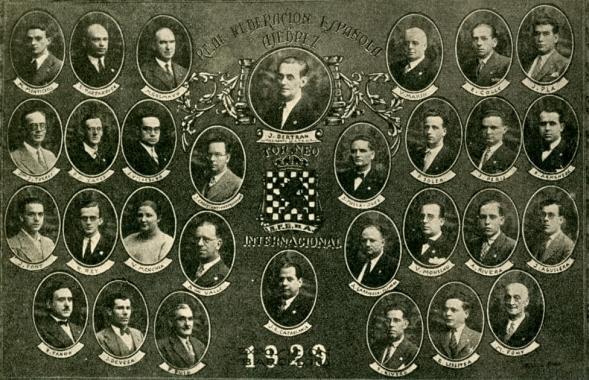
When contacting us by e-mail, correspondents are asked to include their name and full postal address and, when providing information, to quote exact book and magazine sources. The word ‘chess’ needs to appear in the subject-line or in the message itself.
| First column | << previous | Archives [38] | next >> | Current column |

For a larger version, click here.
This illustration from Barcelona, 1929, containing many little-known portraits, was published on page 182 of the November 1929 American Chess Bulletin. Are readers able to trace a better/clearer copy?
Page 148 of Kings, Commoners and Knaves and page 293 of Chess Facts and Fables discussed the origins of the term ‘Dragon Variation’ in the Sicilian Defence, and the earliest citation we have found comes only from the mid-1920s, on page 43 of the February-March 1925 Tijdschrift van den Nederlandschen Schaakbond. After 1 e4 c5 2 d4 cxd4 3 Nf3 Nc6 4 Nxd4 Nf6 5 Nc3 d6 6 Be2 g6, H. Weenink referred to ‘De “drakevariant” van den Siciliaan’.
Pre-1925 citations are sought, and in the meantime we quote an author who considered the Dragon Variation to be a line for White. The game below was annotated on pages 52-53 of Les échecs par la joie by Aristide Gromer (Brussels, 1939), and we give only the notes relevant to the ‘Dragon’ name:
Aristide Gromer – A. Baulier [‘Beaulier’]
French Championship, Toulouse, 1937
Sicilian Defence
(‘... La “Sicilienne” se distingue principalement par un effort des Noirs sur l’aile Dame tandis que les Blancs portent leur activité sur l’aile Roi. La variante la plus caractéristique de cette conception stratégique est la variante dite “du Dragon”, dont nos disciples trouveront un spécimen dans la partie qui suit.’) 1 e4 c5 2 Nf3 Nc6 3 d4 cxd4 4 Nxd4 Nf6 5 Nc3 d6 6 Be2 (‘Le coup préparateur de l’avance à la dragonne future.’) 6...g6 7 Be3 Bg7 8 O-O O-O 9 Nb3 Be6 10 f4 Na5 11 f5 Bc4
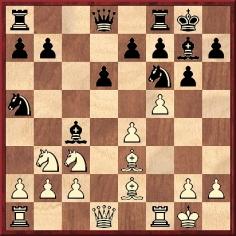
12 g4 (‘Le coup constitutif de la variante dite du “Dragon”. Il faut d’ailleurs faire bien attention à ce que le Dragon ne perde pas son souffle; car les Blancs découvrent leur Roi et une contre-attaque des Noirs serait des plus dangereuses.’) 12...Rc8 13 Bd4 a6 14 g5 (‘Dans ce genre d’attaques à la dragonne, il ne faut pas perdre de temps.’) 14...Bxe2 15 Nxe2 Nh5 16 Bxg7 Nxg7 17 Nbd4 Nc4 18 Qc1 d5 19 b3 Ne5 20 f6 exf6 21 gxf6 Nh5 22 Qg5 Nd7 23 e5 Re8
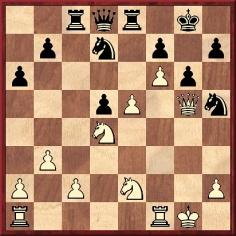
24 e6 Ndxf6 25 exf7+ Kxf7 26 Nf4 Qb6 27 Rad1 Nxf4 28 Rxf4 Kg7 29 Kh1 Re4 30 Rxe4 dxe4 31 Nf5+ Resigns. (‘L’attaque du “Dragon” est une attaque dangereuse. Elle doit être conduite de la part des Blancs avec célérité (comme toutes les attaques) car les Noirs ont d’intéressantes possibilités de contre-attaque.’)
Have other writers used ‘Dragon Variation’ for the pawn advance g2-g4 in the Sicilian Defence? We wonder too how well known the term was in any context during Gromer’s career. For instance, pages 571-572 of L’Echiquier, February 1927 had a French translation of Kmoch’s annotations to a game (Kostić v Canal, Meran, 1926) which began 1 e4 c5 2 Nf3 Nc6 3 d4 cxd4 4 Nxd4 g6; the note to Black’s fourth move included a reference to ‘La “Drachen” variante choisie ici’, implying unawareness that use was being made of a German term for the Dragon Variation.
Aristide Gromer (born in 1909) was discussed on pages 175-177 of Chess Facts and Fables, and we still have no information about him from the 1940s onwards. The picture below was published opposite page 80 of El Ajedrez Español, November 1934.
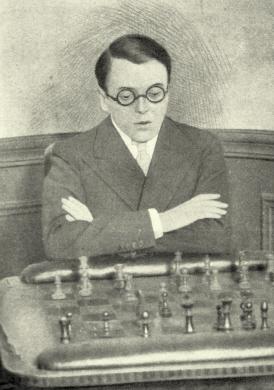
Aristide Gromer
Joost van Winsen (Silvolde, the Netherlands) submits an interview with Gunsberg which was published in the Bradford Observer Budget of 28 July 1888. The copy currently available is imperfect, and a couple of the dates in the extensive extracts below are marked as uncertain:
‘A Chess Champion Interviewed
Mr I. Gunsberg, who is one of the greatest of living chessplayers, was in Bradford a few days ago, and ... one of our representatives waited upon him, and obtained in conversation the following interesting particulars of his life’s history. Mr Gunsberg is a native of Hungary, and only 33 years of age. When a mere boy of 11 his father taught him the elements of chess, that being at a time when the Hungarian Chess School was represented by such players as Fähndrich, Englisch, Kolisch and Dr Noa. Shortly afterwards young Gunsberg went to live in Paris, where at the Café de la Régence – a renowned chess resort – he encountered the strongest players in the capital. He, of course, received great odds from the recognized masters, such as Rosenthal, Steinitz and Kolisch, but against amateurs he was already able to hold his own, though at this time under 12 years of age. Four years later he was considered “a pawn and two moves” player; that is to say, he received the odds of pawn and two moves from the masters. In 1867 he returned to Pesth, his native town, and proved himself to be as good a chessplayer as any of the Hungarians, Schwarz, Englisch and Fähndrich excepted.
The year 1876 [?] found Gunsberg in England, a frequenter of the London chess resorts, and a formidable antagonist. ... Then he disappeared from the chess resorts with unaccountable suddenness, and little was seen of him for upwards of three years. [There followed a brief account of Gunsberg’s involvement with Mephisto.]
The mysterious element in Gunsberg’s doings having ultimately been demolished, Gunsberg reappeared in the public arena. Very shortly after he resumed public play he challenged so redoubtable an opponent as Blackburne to a match, and a contest was arranged in which the Englishman conceded the odds of two games, and won by a single game. The same year Gunsberg won the second prize in the City of London Handicap, and three years later he gained the first honours in the same annual competition. At this time – in 1884 [?] – it was beginning to be recognized that Gunsberg was no mere second-rate master. [The newspaper item then discussed Gunsberg’s relations with Bradford and other events in which he had participated.]
Questioned as to his relations with Steinitz, Mr Gunsberg said he had played one game against Steinitz when the latter was giving a simultaneous performance in 1877, and that he (Gunsberg) lost. He added that he considered Mr Steinitz undoubtedly the strongest living exponent of the game. He should very much like to play him a match, but not until his play got a little more mature. Gunsberg frankly admits that his weakness as a chessplayer is impetuosity in attack, and he observed that when he did undertake to play the champion he should stand a good chance, the natural inference from that statement being that he means to prepare himself for the encounter. Steinitz is not exactly notorious for friendliness of feeling toward other noted chessplayers. Regarding this point Gunsberg says he met Steinitz frequently for years, and was on friendly terms with him, but he doubts whether the champion would still feel inclined to be very amiable to him, though his own feelings towards him are unaltered.
The conversation turned at length upon the forthcoming International Congress at Bradford. Judging from the great variety of events, he thinks this congress will be the finest provincial chess meeting ever held. Up to the present time, he said, only Germany has been able to arrange successful provincial gatherings of so extensive a kind. In no other country have chessplayers ever succeeded in having a meeting of such importance outside the capital. He declined to prophesy as to the probable winner of the Masters’ Tournament, but has sufficient confidence in himself to express the opinion that his chances are as good as those of anybody else. He is in very fair form at present, but, as everybody knows, is very liable to sudden physical depression.
Speaking generally of the uses and effects of chessplaying, Gunsberg said that, if practised in season and in proper measure, it was the best of all pastimes, even for men whose profession greatly exercised the mind, always provided that they did not neglect physical exercise. In fact, he continued, it seems that those engaged in hard brain work require additional brain work as a recreation, just as those engaged in hard physical labour chiefly require manual exercise in their pastimes. All that is necessary to constitute either mental or physical recreation are change and interest. To attain perfection as a chessplayer, Mr Gunsberg said a man must have a combination of the qualities of physical vigour, strong imagination, logical mind, patience, perseverance, industry and mind force, all of which the game of chess developed to some extent. He believed that in the degree in which any of those qualities are undeveloped or lacking the play is weakened. Book knowledge he regards as not absolutely necessary to success, for, whilst on the one hand it gives the player the benefit of the accumulated experience of the best students of the present and past age, on the other hand want of it leads to more self-reliance and independence of thought. Almost the same argument answers to the necessity of a good memory. Mr Gunsberg admitted that he possessed neither of these qualities. The possession of either or both of them would greatly strengthen his play, but would also alter the style of it considerably ...’
The following month Gunsberg won the Bradford tournament, ahead of Mackenzie, von Bardeleben, Mason, Burn, Blackburne and Weiss.
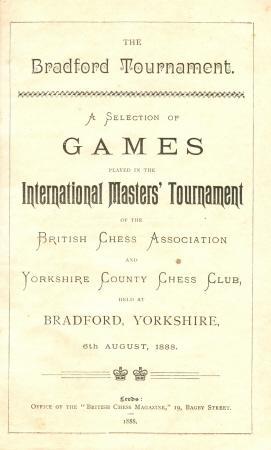
Pages 171-172 of the 30 July 1893 issue of Emanuel Lasker’s magazine the London Chess Fortnightly quoted some remarks about Gunsberg by Steinitz in the New York Tribune. The context was a dispute over whether Lasker had a right to issue a world championship challenge to Steinitz, and we give merely the start of the latter’s salvo (which Lasker quoted approvingly):
‘Mr Gunsberg is not alone a chess professor, but he also professes to be a philosopher of the so-called “individualistic school”, and he has lectured and written on doctrines which, if I may quote myself, are based on the theory that “one man has rights, but two men have none”. When, however, he applies his egoistic principles to chess affairs, he finds that though he may be unique in the chess world he is not alone in it. For instance, he seems to be possessed of the idea that the championship of the world can only be at stake when he himself is a party in a contest. Thus he played a match with Chigorin for “the championship of the world”, and the whole chess world laughed. He fought another for the title against myself in which he virtually received the odds of the draw and played to take advantage of the odds. The whole chess world might have laughed if – he had won it ...’
We are still seeking information about the meeting between Gunsberg and Capablanca depicted in the photograph below from page 497 of The Strand Magazine, May 1914 (C.N. 3785):
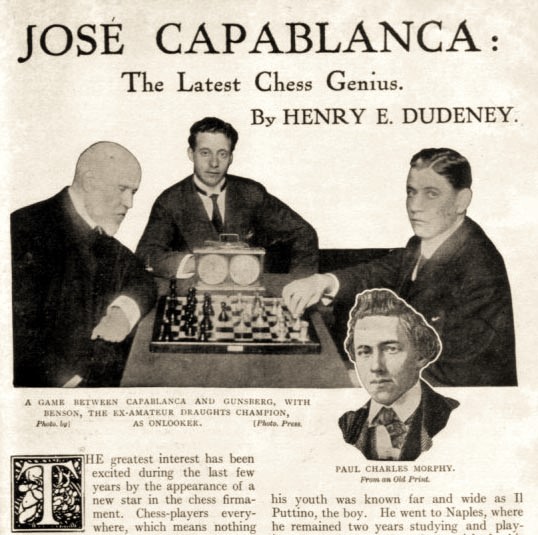
A further question is why Gunsberg’s forename was, during his lifetime, so often given as J., rather than I. To quote just one late example, the Marienbad, 1925 tournament referred to ‘J. Gunsberg’.
On the other hand, the initial I. was, fortunately, used in the acrostic poem by W. Williams published on page 275 of the Chess Player’s Chronicle, 29 November 1890:
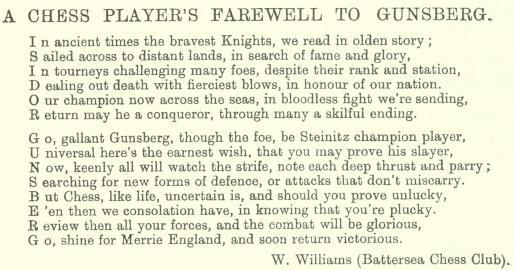
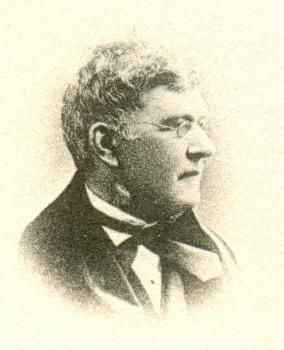
This is George Allen (1808-76), in a picture published opposite page 22 of Chess in Philadelphia by Gustavus C. Reichhelm (Philadelphia, 1898).
From page 515 of the December 1973 BCM:
‘If, in the magazine, we were to remove every item which some reader dislikes, we may well be left with two staples – and then we’re certain someone has already complained about their quality.’
Further to G.H. Diggle’s reference to Savielly Tartakower in C.N. 4331, Hassan Roger Sadeghi (Lausanne, Switzerland) asks if more information is available about Tartakower’s service in the Fighting French Forces during the Second World War under the pseudonym ‘Cartier’.
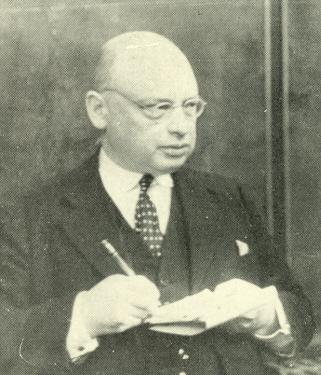
Savielly Tartakower
We offer some notes, beginning with a paragraph by Harry Golombek on page iii of his Translator’s Foreword to the second volume of Tartakower’s Best Games:
Coming through the war unscathed, he resumed his chess activities with undiminished vigour.’
In that source, as well as on page 67 of Chess Treasury of the Air by Terence Tiller (Harmondsworth, 1966), Golombek related his wartime meeting with Tartakower in England. The following appeared in the Tiller book:
The chess match was played at the Borough Club, Nottingham on 15 November 1941, as reported on pages 305-306 of the December 1941 BCM, and the score of the game between ‘2nd/Lt. G. Cartier’ and ‘Bdr H. Golombek’ was supplied. The BCM wrote:
Below is the complete page 306:

In all, the BCM published about a dozen games by Lieutenant Cartier during the War. The match described by G.H. Diggle took place in London on 22 April 1944 and was reported on pages 107-109 of the May 1944 BCM. His opponent was G. Wood. The pseudonym ‘Cartier’ was no secret; for instance, page 268 of the December 1942 BCM referred to ‘Lt. G. Cartier of the Fighting French, better known in the chess world as Dr Tartakower, the great international’.
We still seek substantiation of the claim that Tartakower was several times ‘dropped by parachute behind enemy lines on secret missions’ (see page 331 of Kings, Commoners and Knaves). More generally, what else is known about Tartakower’s activities during the Second World War?
Javier Asturiano Molina (Murcia, Spain) requests details regarding Paul Morphy as a problem composer.
On pages 17-18 of Paul Morphy The Pride and Sorrow of Chess (New York, 1976) Lawson’s treatment of the famous Morphy two-mover covered the following points:
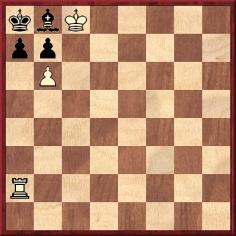
Mate in two
It is worth casting an eye over earlier attempts to sort out the facts about the two-mover. Alain C. White wrote on page 157 of his book The White Rooks (Stroud, 1910):
‘It would be curious to know the origin of this little trifle. I have not traced it back further than 1888, when H. Lehner the editor of the Lesehalle referred to it as the only problem composed by Morphy. Seeing the wonderfully subtle mates which Morphy was able to announce in his actual games, the production if genuine is also disappointing.’
Sergeant quoted most of that passage on page 347 of Morphy’s Games of Chess (London, 1916), and on page 110 of his complementary book Morphy Gleanings (London, 1932) he added:
‘On the authority of General John Tillson of Quincy, Illinois, this was a Morphy problem, composed by Paul before he was ten (!), and was shown to him by Ernest Morphy before his nephew made his great reputation. The problem was first published, apparently, by G.C. Reichhelm in the Philadelphia Times in 1887, which is earlier by a year than A.C. White’s first trace of it. It was republished in the Philadelphia Inquirer as late as 18 February 1920 (with the pieces transposed to the king’s side), and was prefaced by a reference to General Tillson’s statement.’
On page 11 Sergeant specified the chronology: after Reichhelm gave the problem in the Philadelphia Times in 1887 Tillson wrote to him about Morphy’s young age at the time of composing it. It would seem, though, that Sergeant’s source was merely the (1920) republication of the story, and that he did not have the Philadelphia Times of 1887. Can any reader provide that earlier text?

On page 327 of his book Lawson discussed a problem which ‘has often been falsely ascribed to Paul Morphy’. He reported that it was, in fact, by E.B. Cook, and ‘was first published under the initials “E.B.C.” by C.H. Stanley on 23 October 1852 in the New York Albion. Dr H. Keidanz published it as number 15 in The Chess Compositions of E.B. Cook.’
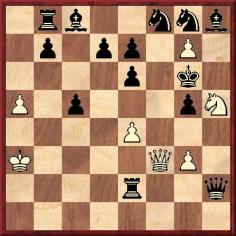
Mate in eight
Sergeant mentioned on page 347 of his book that the composer was Cook, not Morphy:
‘Another [problem] which was attributed to him in the Nuova Rivista degli Scacchi, July-August 1884, was afterwards traced to the late Eugene B. Cook, of Hoboken, being the well-known “Circus” Fantasy.’
In a later edition of the book (1919) Sergeant revised his comment as follows:
‘Another [problem], in eight moves, published as Morphy’s in the Chess Player’s Magazine, August 1864, is said to have been really composed by the late Eugene B. Cook.’
We add that the eight-mover was often seen ascribed to Morphy after his death, examples being page 66 of the Columbia Chess Chronicle, 1 October 1889 and the front page of the first number of the Chess Review, September 1892, as well as page 97 of the February 1893 issue. However, after it was given on page 83 of the April 1922 American Chess Bulletin Alain C. White reacted with a letter to the problem editor of the Bulletin, H.W. Barry. It was published on page 112 of the May-June 1922 issue:
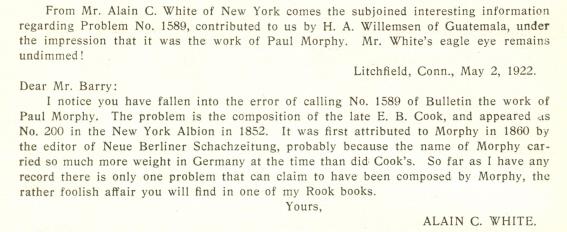
Can anything further be discovered as to how Morphy’s name became attached to Cook’s composition?
John Blackstone (Las Vegas, NV, USA) writes:
‘On page A8 of the Los Angeles Times of 13 November 1927 a column called “Chess” by Clif Sherwood stated:
“United States champion Frank J. Marshall, in his chess department of the November issue of the Sportsman, gives the following ...”
What, if anything, is known about that magazine?’
To our brief list of authors of books on both chess and bridge (G. Abrahams, A. Chéron, Em. Lasker and J.C.H. Macbeth) we add a fifth name: Philip Anderton. In addition to Bridge in 20 Lessons, Contract Bridge Simplified and Play Bridge he brought out A Basic Chess (London, 1955).

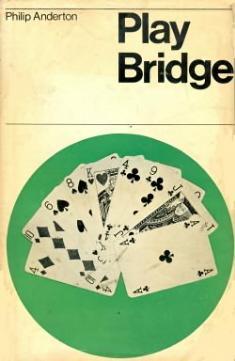
A short work with an ungainly title, A Basic Chess was notable for its unusual notation. To quote a gamelet from page 32: (1) 26-36 75-55 (2) 27-47 84-48 mate.
Is information available about Philip Anderton?
Books continue to claim, without substantiation, that the title of ‘grandmaster’ was first conferred by Tsar Nicholas II at St Petersburg, 1914. The matter was discussed on pages 315-316 of Kings, Commoners and Knaves and pages 177-178 of A Chess Omnibus, and we have still found no earlier occurrence of the story than in an article by Robert Lewis Taylor in The New Yorker, 15 June 1940.
To pose a broader question: do 1914 sources contain references to Tsar Nicholas II in connection with any aspect of the St Petersburg tournament?
From pages 24-25 of Not Only Chess by Gerald Abrahams (London, 1974):
‘... Cold-blooded gamesman-planning is rare. But I have one pretty example. At my first British Championship, [at Ramsgate] in 1929, a friend of mine – who is a magnificent analyst and celebrated in the chess world – found himself in a very bad position. But there was a way out. Given that his opponent (a very strong player) did not see the threat, it was possible, with a series of sacrifices, to achieve stalemate. But he had to include in his play a clearly inadequate move, which would inevitably warn his opponent. After all, one plays chess on the assumption that the opponent sees everything. (That is why the word “trap” is not a good chess term.) But my friend devised a psychological trap. He sat and looked at the board with a despairing face until he was well and truly in time trouble. Then he fumblingly made the crucial moves. His opponent, tempted to a little gamesmanship himself, was playing very quickly. Quick came the erroneous capture. Even quicker came the series of sacrifices and, while the flag was tottering, stalemate supervened. Now could he have improved on things in the following way: touched the piece, taken his hand away, and let himself be compelled to move the piece at random? No, he had thought of that, but dismissed it as sharp practice.’
Abrahams then gave the relevant position:
‘Time control at move 40. At move 31 Black has played R-Kt6, a good move, because, if either rook guards the bishop, RxB wins.’
Play continued: 32 Bd2 Rg3+ 33 Kh1 Rxh3+ 34 Kg1 Rd3 35 Bc1 (‘Leaving himself less than half a minute on his clock.’) 35...Rc7 36 Bg5 (‘Finger staying on his clock; and Black falls for it.’) 36...Rg3+ 37 Kh1

37...Rxg5 38 R1f7+ Rxf7 39 Rxf7+ (‘Forcing stalemate or perpetual check.’).
Abrahams did not name the players, but the position after White’s 37th move was given on page 346 of the September 1929 BCM. W.A. Fairhurst was White against T.H. Tylor.
For similar deeds, see the entry for ‘Cunning, gamesmanship and skulduggery’ in the Factfinder.
John Hilbert (Amherst, NY, USA) quotes from pages 130-131 of the Chess Weekly, 18 September 1909:
‘Speaking of the peculiarities of chessplayers, the man who writes the biography of the World’s Chess Champion will face a Herculean task. Our friend Dr Lasker is a most interesting psychological study, and in all that has been written about his personality we have never seen anything even approaching the truth. Sharing the failings of many great men, Dr Lasker measures his capacities in all lines of endeavor by his phenomenal genius in one. He prides himself more on his business abilities and on his knowledge of things miscellaneous than he does on chess, wherein he is admittedly pre-eminent. Tell him that he has an equal in chess and he will modestly admit it, or perhaps mildly debate the question; but tell him that he has an equal in philosophy, in the sciences – or in pinochle – and you may hurt or offend him. His thoughts, sometimes inconsistent, often impractical, but always unique, reflect a vortex of diverse personalities – An Aristotle, A Claudius, A Nero and a George Peabody, rolled into one and inspired to play chess.’
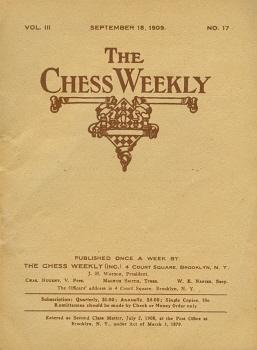
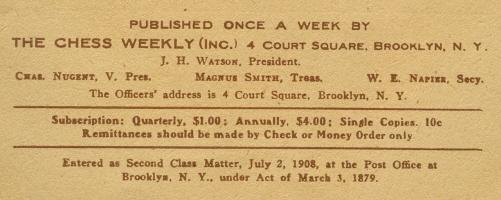
Front cover of the 18 September
1909 issue
Noting that Magnus Smith was listed as the ‘Editor-in-Chief’ of the Chess Weekly on the (inside) mast-head, the names of Nugent and Napier having been removed therefrom the previous month, our correspondent comments:
‘I think that the Smith paragraph is well done and features perhaps the most incisive words written about Lasker’s personality by anyone on this side of the Atlantic, certainly for the time.’
Our feature article on Zugzwang remarks that the word ‘was not commonly found in English-language chess literature prior to the publication of My System [in 1929]’. Here we add that a rare, early explanation of Zugzwang occurred in an (uncharacteristically florid) article by Hermann Helms entitled ‘Applying the Straitjacket in Chess’ which was originally published in the Brooklyn Daily Eagle and was reproduced on pages 65-66 of the March 1927 American Chess Bulletin. It concerned Capablanca’s celebrated victory (with the Caro-Kann Defence) over Nimzowitsch at New York, 1927, and Helms commented:
‘It was an artistic gem of the chessboard. Nimzowitsch is an artist. No-one appreciates beauty or perfection more than he. His own artistry has often dumbfounded opponents less skillful. But against the champion – that’s something different again.
Once more, that straitjacket; that is, the chessic kind. ... His little army was precisely as large as Capablanca’s. But he was cramped and he ached for elbow room. As to space and mobility he was much restricted. No matter which way he looked there was restraint. The prospect was decidedly irksome.
Very expressive is the German term of “Zugzwang”. It covers the case exactly. Literally translated it means move-coercion. The player thus unfortunately placed may be said to be position-bound. Gradually all his available moves are exhausted; that is, the moves that count at all. Then he faces the inevitable.
... Some move must be made. With that very move he signs his own death warrant ...
So it was with Nimzowitsch. He was the fly in the net. Capablanca played the part of spider. The Dane was already enmeshed. He made a brave show of resistance. The more he struggled the more hopeless became his plight. The Cuban looked pleased. On an occasion like this he fairly beams. His countenance yesterday radiated delight.’
C.N. 5090 discussed the origins of the dictum ‘Counter-attack is the best form of defence’. We quoted ‘La contre-attaque est une excellente manière de se défendre’ on page 51 of Nouveau manuel illustré du jeu des échecs by J.A. de Rivière (Paris, 1892), noting that, since it was not the first edition of the book, it might well be possible to trace the idea further back.
Vasco Resende (Le Mans, France) now confirms that the identical passage appeared in the original edition (undated, but published in Paris in 1860 or 1861).
Below is an extract from Worlds of Chess Champions, a booklet issued by the Cleveland Public Library in October 2003:

As regards the illustration, it may be recalled that C.N. 3397 (see page 287 of Chess Facts and Fables) quoted the following passage about Labourdonnais by Sam Loyd on page 1884 of the Scientific American Supplement, 6 April 1878:
‘It is not generally known that a plaster cast was taken from his features at the time of his death and was brought to this country, and is at present in the possession of Mr Eugene B. Cook, the distinguished problemist, who prizes it most highly and takes peculiar pride in showing the stray locks of hair and whiskers that still adhere to the plaster.’
The following page of Worlds of Chess Champions has a good portrait of Paul Morphy, although presented in reverse. It is reproduced correctly here:
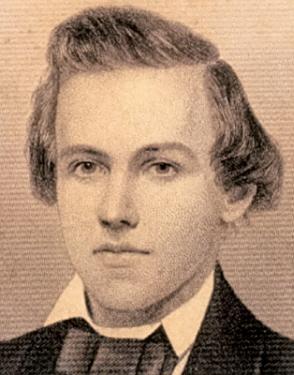
Carsten Hansen (Bayonne, NJ, USA) reports that the chess author Svend Novrup has also written books on bridge. Below is the front cover of a volume published in Copenhagen in 1971:
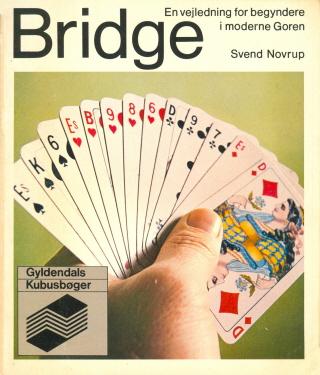
Little-known nineteenth-century occurrences of the term ‘grandmaster’ are always welcome. Robert John McCrary (Columbia, SC, USA) forwards one from page 324 of the Chess Player’s Chronicle, 1854:
‘Many a player can conduct a game without the board coolly and steadily, but who, save De la Bourdonnais, under such circumstances, invented attacks profound in conception, brilliant in execution, and enduring upon analysis? Who but the Chess Grand-Master could have contested a game without the board against a player like Boncourt, with the remotest chance of success?’
Recommended for German speakers: Burghart Klaußner’s fine reading of Robert Löhr’s novel about Wolfgang von Kempelen’s invention, Der Schachautomat (five CDs produced by Der Audio Verlag GmbH).
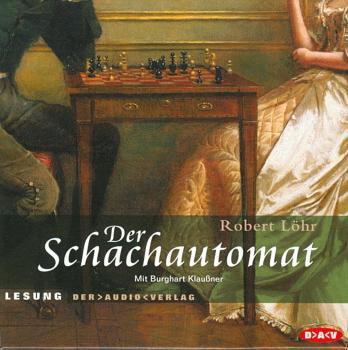
Concerning the book itself, we note from the dust-jacket of the English edition, The Chess Machine (New York, 2007), that ‘the rights have been sold in more than 20 countries’.
Relatively early pictures of Isidor Gunsberg are uncommon, and we were glad to find the one below in Hans von Minckwitz’s column on page 21 of the Illustrirte Zeitung, 5 July 1890:
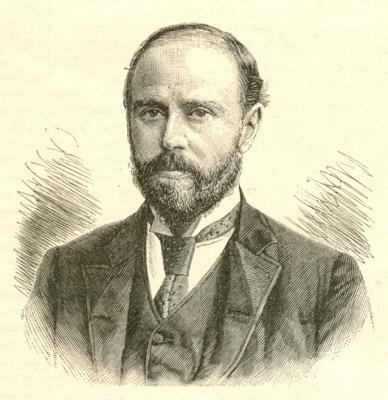
An attempt is made here to progress with an unresolved matter
from page 201 of Kings, Commoners and Knaves, and we
therefore begin by quoting in full the relevant part of our text:
Middle-game combinations can also be the subject of duplication, but here too one must be wary, since chess chroniclers often write n’importe quoi. On page 39 of the March 1992 Europe Echecs, Sylvain Zinser asserted that the following position had arisen in ‘Blackburne v Gifford, England 1874’:
The finish is given as 1 Qxc6+ Kxc6 2 Ne5+ Kc5 3 Nd3+ Kd4 4 Kd2, and mate next move by 5 c3 is unavoidable. But this position bears an uncanny resemblance to the following, widely published in chess literature:
Kasparyan v Manvelyan, simultaneous display, USSR, 1936. White won with 1 Rxc6 Bxc6 2 Qc4+ Kb7 3 Qxc6+ Kxc6 4 Ne5+ Kc5 5 Nd3+ Kd4 6 Kd2 Qe6 7 c3 mate.
The question is why Zinser (and only Zinser, to our present knowledge) ascribed the 1 Qxc6+ combination to Blackburne, and now we may have the makings of an explanation. Below are pages 98-99 of The Middle Game in Chess by Reuben Fine (New York, 1952):
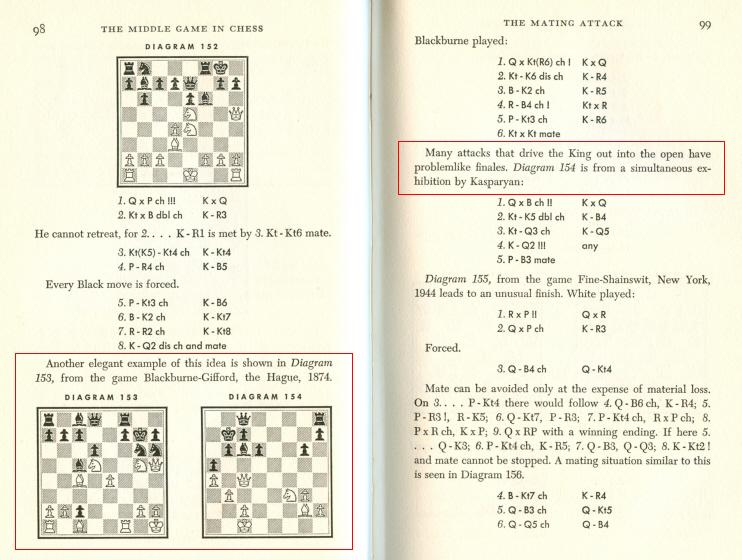
The Blackburne and Kasparyan positions are presented by Fine side by side, which may have resulted in his reference to ‘Blackburne-Gifford’ being misread as relating to diagram 154, instead of 153.
That still leaves two discrepancies, however. Firstly, whereas
Fine stated that the game was played in the Hague (which is
confirmed by, inter alia, page 154 of P. Anderson Graham’s
book on Blackburne), Zinser placed the game in England. Secondly,
Black’s king’s-side units in Fine’s diagram are omitted by Zinser.
It is, of course, possible that these divergences were introduced
elsewhere by another writer (i.e. after Fine and before Zinser).
We still lack definitive information about the Kasparyan position, which has been published over the years with varying details, though never, it seems, with the full game-score. Is a good, solid source from the 1930s available?
Biographical information on H. Gifford is scarce. He was a participant in, for instance, the Paris, 1878 tournament and appears in the group photograph on page 38 of A Picture History of Chess by Fred Wilson (New York, 1981). Below is another of his games against Blackburne. It was played at Simpson’s Divan and is culled from page 153 of the Brooklyn Chess Chronicle, 15 July 1887:
H. Gifford – Joseph Henry Blackburne1 e4 e5 2 f4 exf4 3 Bc4 b5 4 Bxb5 Qh4+ 5 Kf1 f5 6 Qe2 Nf6 7 exf5+ Be7 8 Nc3 Bb7 9 Nf3 Qh5 10 d3 O-O 11 Bc4+ d5 12 Bb3 Bd6 13 Qe6+ Kh8 14 Nxd5 Nbd7 15 Nxf6 Nxf6 16 Qe2 Nd5 17 Bxd5 Bxd5 18 Bd2 Bc5 19 Re1 Qxf5 20 Qe5 Qd7 21 h4 Rae8 22 Qc3 Be3 23 Rh3 Qg4 24 Re2 Bxf3 25 Rxf3 Qxh4 26 Rh3
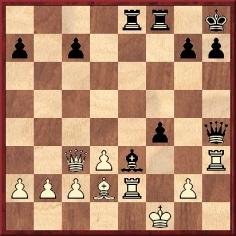
26...f3 27 Rxh4 fxe2+ 28 Kxe2 Bd4+ 29 Re4 Rf2+ 30 Ke1 Rxe4+ 31 dxe4 Bxc3 32 Bxc3 Rxg2 33 White resigns.
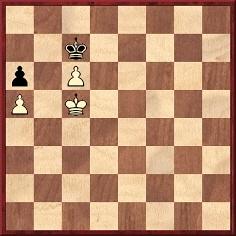
This ending is usually published in books with the caption ‘Fahrni-Alapin’ (see pages 42-43 of A Chess Omnibus), but we are grateful to Anssi Korhonen (Helsinki) for pointing out that the position appeared in Emanuel Lasker’s Common Sense in Chess. Depending on the edition, the page numbers are 108-110, 108-109 or 126-127. The first of these references relates to the original edition of 1896.
Lasker wrote:
‘White has two chances of winning, the one based on his passed pawn, the other on the weakness of the black RP. The black K occupies at present a position of advantage in regard to both. This is changed by the following manoeuvre:
1 K-Q5 K-B 2 K-B4 K-Q 3 K-Q4 K-B 4 K-Q5 K-B2 5 K-B5.
Now the move is changed, and White wins easily; or
4...K-Q 5 K-Q6 K-B 6 P-B7 K-Kt2 7 K-Q7
and mates in a few more moves.’
John Hilbert (Amherst, NY, USA) has been examining issues of the Washington Times, which, together with many other US publications of the period 1900-1910, are available on-line courtesy of the Library of Congress. Our correspondent writes:
‘There was a short-lived chess column in the Washington Times that ran from 7 November 1903 to 30 April 1904. Initially edited by W.B. Mundelle, it was taken over by F. Edward Mitchell as from 12 March 1904, because Mundelle had retired and moved to San Antonio, Texas for health reasons. On page 8 of the 21 November 1903 issue the column gave this forgotten game played at the Washington Chess Club:
Harry Nelson Pillsbury (blindfold) – F.N. Stacy
Washington, 14 November 1903
Falkbeer Counter-Gambit1 e4 e5 2 f4 d5 3 exd5 e4 4 d3 Nf6 5 Qe2 Bc5 6 dxe4 O-O 7 Nf3 Ng4 8 Nc3 Bf2+ 9 Kd1 Bb6 10 Ke1 c6 11 h3 Nf2 12 Rh2 Re8 13 Be3 Bxe3 14 Qxe3 Nxe4 15 Nxe4 cxd5 16 Rd1 Bf5
17 Rxd5 Qxd5 18 Nf6+ gxf6 19 Qxe8+ Kg7 20 g4 Bd7 21 Qe3 Nc6 22 Rd2 Qa5 23 Kf2 Re8 24 Qd3 Be6 25 a3 Qb6+ 26 Kg2 Qxb2 27 f5 Bc8 28 Qb3 Qxb3 29 cxb3 Re3 30 Rd3 Rxd3 31 Bxd3 Ne5 Drawn.
In that blindfold display Pillsbury played simultaneously eight games of chess (+5 –0 =3) and four of checkers (+0 –1 =3).
The same column gave the ending of the Pillsbury v Guthrie draw, whose full score appeared (although only with the heading “USA 1904”) on pages 273-274 of Jacques N. Pope’s book on Pillsbury. That game occurred in a second display at the Washington Chess Club on 14 November 1903 (19 chess games and seven games of checkers, played simultaneously but not blindfold).
That column of 21 November 1903 also included the scores of two checkers games by Pillsbury, against F.E. Potts and Paul F. Grove.
On page 3 of its 9 April 1905 issue the Washington Times had a news story about Pillsbury entitled “Tragic collapse of a brilliant mind”. By way of example, the first paragraph reads:
“When Harry Nelson Pillsbury, the American champion chessplayer, one time champion of the world, and probably the most marvelous trick chessplayer that ever lived, tried to commit suicide in Philadelphia during a fit of insanity a few days ago, he only fulfilled the fate which has been that of nearly all of the great masters of the game. The tremendous mental strain which they undergo in the great tournaments, aided and abetted by excessive use of stimulants to keep them keyed to the proper pitch, is too much for the human brain, no matter how abnormally brilliant.”’
Below is the score of a game of checkers won by Pillsbury in Washington on 14 November 1903, as mentioned in C.N. 5158:
‘And this is what Mr Pillsbury did to Paul F. Grove. Pillsbury’s move.’ f6-e5 c3-d4; e5-c3 b2-d4; h6-g5 a1-b2; d6-c5 g3-f4; g5-h4 d2-c3; g7-h6 d4-e5; e7-d6 e3-d4; c5-e3 f2-d4; h8-g7 e1-f2; f8-e7 f2-e3; e7-f6 g1-f2; d8-e7 c3-b4; h6-g5 f4-f8. ‘All over.’
Source: Washington Times, 21 November 1903, page 8.
For readers’ convenience we have converted the score from ‘11-15 22-18’, etc. to the algebraic notation.
Regarding Janowsky’s alleged use of ‘blind swine’ to describe two rooks on the seventh rank, James Stripes (Spokane, WA, USA) points out that the attribution appeared in V. Vuković’s book The Art of Attack in Chess; see, for instance, page 73 of the 1993 edition published by Cadogan Chess.

Vuković gave this diagram with the caption ‘Blind swine’ and stated:
‘The pair of rooks which “grunt out check” on the seventh rank but cannot get a sight of mate were once nicknamed “blind swine” by Janowski.’
Our correspondent cites two games in which Janowsky could only draw despite having his rooks on the seventh rank: his tenth match-game against Showalter in New York, January 1899 (American Chess Magazine, February 1899, pages 360-361) and his first-round encounter with Marshall at New York, January 1913 (American Chess Bulletin, March 1913, page 54).
This position gave rise to a famous move:

After 31 Bc7 Black resigned.
It is strange how often, nowadays, this game is merely labelled ‘Tarrasch v the Allies’, as if the identity of the losers were unknown. They were D. Marotti, E. Napoli, de Simone and del Giudice, as is shown by such sources as pages 120-121 of Deutsches Wochenschach, 5 April 1914 and pages 180-182 of Schachjahrbuch für 1914 II. Teil by L. Bachmann (Ansbach, 1914).
The four names were also given by Tarrasch when he annotated the game (played at the Circolo Artistico in Naples on 9 March 1914) in the Berliner Lokal Anzeiger; those annotations were reproduced on pages 162-163 of La Stratégie, April 1914. The names also appeared when the game was presented on pages 398-399 of Tarrasch’s book Die moderne Schachpartie (Leipzig, 1924) and on pages 168-170 of Tarrasch’s Schachzeitung, March 1934 (published after his death). In these last two sources ‘Gindice’ was given instead of Giudice. The strongest of the allies was Davide Marotti (1881-1940), who became Italian champion in 1921.
At the 1921 Italian championship, held in Viareggio, one of the participants was M. Romi(h), and Javier Asturiano Molina (Murcia, Spain) asks about the spelling of his name.
Has any writer already sorted out the (rather complex) details? The entry on pages 433-434 of the Dizionario Enciclopedico degli Scacchi by A. Chicco and G. Porreca (Milan, 1971) merely had ‘Romi Max’, whereas page 359 of Jeremy Gaige’s Chess Personalia (Jefferson, 1987) gave ‘Romi, Massimiliano né Romih, Max’. The index (page 631) of Storia degli Scacchi in Italia by A. Chicco and A. Rosino (Venice, 1990) put ‘Romi (Romih), Massimo (Max)’.
This photograph appeared on page 37 of Chess Pie, 1927:
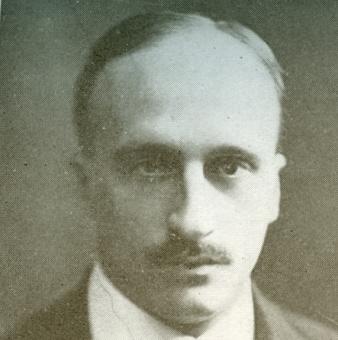
M. Romi/Romih
Page 32 of the same issue stated:
‘Max Romih. Native of Pinguente, Istria, belonging to Trieste. Born 23 May 1893 ...’
Our correspondent, Javier Asturiano Molina, comments that the Romi/Romih spelling question is relevant to the well-known ‘spiritualist’ yarn about a game between Maróczy and Korchnoi, widely discussed on the Internet and elsewhere. It may be recalled that, as a test question, the ghost of Maróczy was purportedly asked whether he recognized the name ‘Romi’. The answer that came back was negative, although he did recall having, in 1930, an opponent named ‘Romih’.
We note, though, that both ‘Romi’ and ‘Romih’ were used in chess literature while Maróczy was alive, seemingly at random. Indeed, Maróczy himself used both. To deal only with his victory over Romi/Romih at San Remo, 1930, the following versions appeared in Maróczy’s writings:
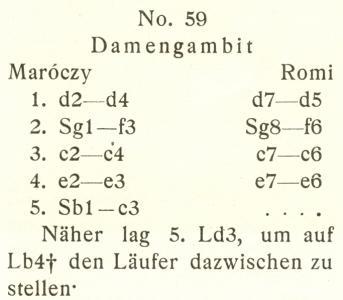
The start of Maróczy’s annotations in Kagans Neueste Schachnachrichten, June 1930, pages 179-181.
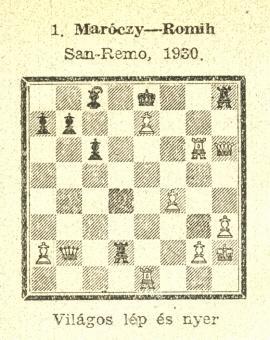
From page 35 of Maróczy’s 1951 book A megnyitások elmélete.
Christian Sánchez (Rosario, Argentina) mentions that the ‘Kasparyan position’ discussed in C.N. 5155 was (after R. Fine and before S. Zinser) attributed to Blackburne v Gifford by L. Pachman:
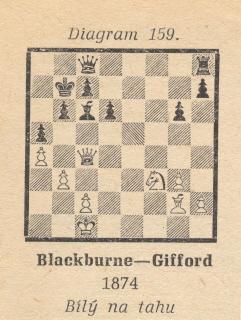
The above is reproduced from volume two of Taktika Moderního Šachu by L. Pachman (Prague, 1964). See also page 76 of the German edition (Moderne Schachtaktik, volume two) and page 64 of the Spanish translation (Táctica moderna en ajedrez, volume two), as well as page 49 of Attack and Defence in Modern Chess Tactics (London, 1973).
Biographical details about Gifford are still being sought. A rare instance of his being named as ‘Birkmyre Gifford’ occurred on page 109 of the April-May 1879 issue of La Stratégie.
It seems to us that the photograph of Pillsbury in the Washington Times of 9 April 1905 (C.N. 5158) was inverted, and therefore a reversed copy is given here:

A further passage about Pillsbury in the Washington Times comes from page 6 of its edition of 26 June 1906, i.e. not long after he died:
‘Horse v Chessplayer
Our highly respected and entertaining contemporary, the Wall Street Journal, is in a parlous state because of the relative attention paid to the deaths of Pillsbury, the chess master, and Sysonby, the racehorse. It grieves especially because of the part journalism played in this discrimination, thus saying:
“The general newspapers give a column and a half and a ‘spread head’ on the first page to an account of the death of a great thoroughbred horse. They give a half column on an inside page to the death of America’s greatest chessplayer, of whom it is said he was ‘one of the mental marvels of the age’. Is a horse better than a man? Does brute strength possess more interest than mental power?”
Even newspapers have to take things as they find them in this world, and a newspaper man in dealing with events that he is to lay before the people must and does take into account the things that will be of most interest to his special public. The constituency of a few papers doubtless had greater concern about the passing of the brilliant chessplayer, but the large majority of readers everywhere felt the deeper interest in the horse. It may not be a very fine commentary on our national spirit, but it is a fact, nevertheless. And newspapers are less molders of public sentiment than they are molded by it.’
From John Townsend (Wokingham, England):
‘I should like to obtain biographical facts about William Harris, who was mentioned in your article on Alexander McDonnell. He seems to have been unusually enthusiastic about chess, judging from his occasional contributions to the Chess Player’s Chronicle in its early years.
Page 159 of volume two gave his address: No. 1, Hill Street, Richmond, Surrey. He offered to continue a correspondence game discussed in an earlier issue, and on that same page he also enquired about “Vida’s Poem”.’
From page 176 of the June 1939 issue of the Tijdschrift van den Koninklijken Nederlandschen Schaakbond:

The occasion was the match between Holland and England in the Hague, 28-29 May 1939.
From Michael McDowell (Westcliff-on-sea, England):
‘I have always understood the problem term “aristocrat” to mean a composition featuring all 16 pieces and no pawns, but many problemists extend the definition to cover any pawnless problem. It seems ludicrous to me to refer to an “aristocratic miniature”, as if there were something surprising or meritorious in a seven-piece problem having no pawns. A pointer to the origin of the term appears in D.J. Morgan’s Quotes and Queries column in the June 1964 BCM (page 180), where he quotes Hermann Albrecht, in the November 1963 Problemist, naming Otto Dehler as the originator of “aristocrat”. An illustrative problem by J.J. Togstad was given, from the Pittsburgh Gazette-Times, 1911. Where did Dehler coin the term?’
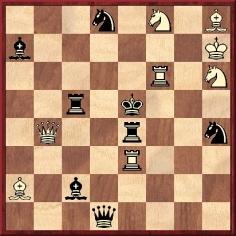
Mate in two.
Our correspondent points out that the Togstad composition (above), which received the second Honourable Mention, also appeared on page 6 of Boerenschroom, M. Niemeijer’s 1965 collection of pawnless two-movers. Pages 46-47 gave eight further ‘aristocrats’, of which the earliest was by A.W. Daniel (dated 1904, but no source supplied):
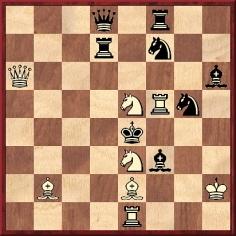
Mate in two.
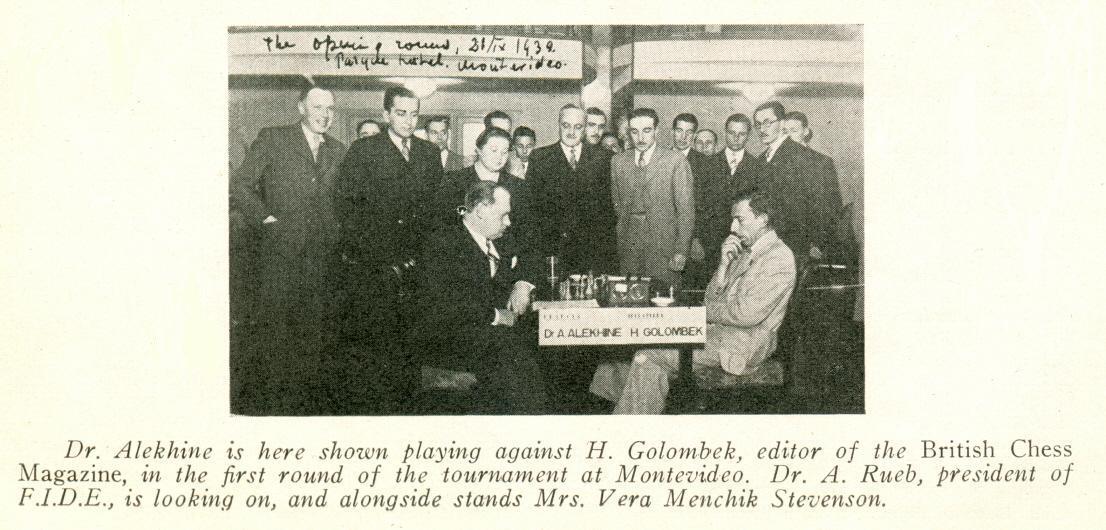
This photograph was published on page 54 of the March-April 1940 American Chess Bulletin. The reference to Rueb is rather surprising.
From page 35 of Famous Chess Players by Peter Morris Lerner (Minneapolis, 1973):
‘Although Alekhine gave up smoking for the world championship, he took up the habit again as soon as the match was completed. One night he went to bed with a lighted cigarette and woke up amid flames. Luckily, he was not injured.’
The following appeared on page 27 of the February 1931 American Chess Bulletin:
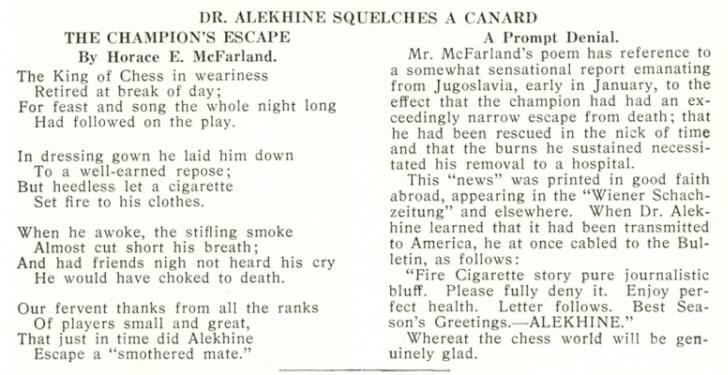
The report in the Wiener Schachzeitung (on page 374 of the December 1930 issue) was nearly 40 lines long.
C.N. 64 (see pages 177-178 of Chess Explorations) showed a victory by James H. Taft over Frank J. Marshall in New York in 1910. It was the first of five games contested, and Marshall’s final score was +2 –1 =2. The American Chess Bulletin, July 1910, page 172 reported that he ‘was fortunate to draw the second game’, and we now learn from John Blackstone (Las Vegas, NV, USA) that the moves were published in the New York Sun, 8 May 1910, third section, page 10:
Frank James Marshall – James H. Taft1 e4 e5 2 d4 exd4 3 c3 dxc3 4 Bc4 Nf6 5 e5 c2 6 Qxc2 d5 7 exf6 dxc4 8 Qe4+ Be6 9 Nc3 c6 10 Nf3 Nd7 11 fxg7 Bxg7 12 Bg5
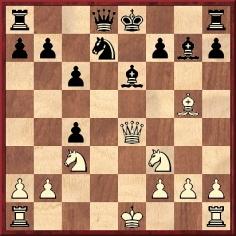
12...Nc5 13 Qh4 Nd3+ 14 Ke2 Qc7 15 Ne4 h6 16 Bf6 Nf4+ 17 Kf1 Ng6 18 Qh5 Bxf6 19 Nxf6+ Ke7 20 Ne4 b6 21 Re1 Rad8 22 Nh4 Nxh4 23 Qxh4+ Kd7 24 g3 Kc8 25 Kg2 Bd5 26 f3 Bxe4 27 Qxe4 Rd2+ 28 Re2 Drawn.
The column can be consulted via the Library of Congress website referred to in C.N. 5158. The Sun had a picture of Taft, of poor quality:
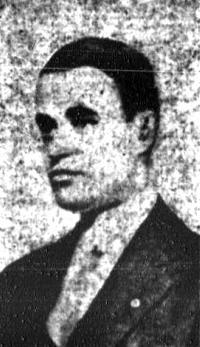
Biographical information about him is still being sought.
1 e4 e6 2 d4 d5 3 Nc3 Nf6 4 Bg5 Be7 5 e5 Nfd7 6 Bxe7 Qxe7 7 Qd2 a6 8 Nd1 c5 9 c3 Nc6 10 f4 b5 11 Nf3 Bb7 12 Bd3 c4 13 Bc2 Nb6 14 Ne3 b4 15 O-O g6 16 Rf2 Qf8 17 Raf1 bxc3 18 bxc3 Qa3 19 Rb1 Qa5 20 Ng4 Ra7 21 Nf6+ Ke7 22 Ng5 h6
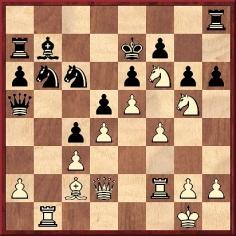
23 Nxf7 Kxf7 24 Bxg6+ Kxg6 25 f5+ exf5 26 g4 Bc8 27 gxf5+ Bxf5 28 Rbf1 Ne7 29 Rxf5 Nxf5 30 Qg2+ Kf7 31 Rxf5 Raa8 32 Nxd5+ Ke6
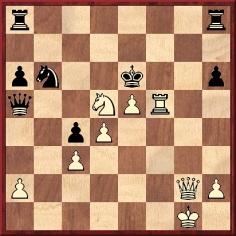
33 Rf6+ Resigns.
Source: New York Sun, 8 May 1910, third section, page 10.
An unusual mate in three was available at the end: 33 Qg6+ Kxd5 34 Rf6, etc.
The game-score was not included in Lasker’s Chess Strategy (London, 1915), which was based on that second German edition.
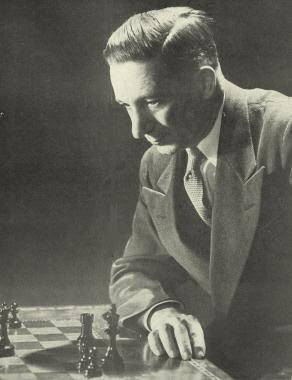
Edward Lasker (front cover,
Chess Review, June 1950)
Lasker described the success of the book in an article on page 7 of the March-April 1943 issue of the Chess Correspondent:
‘I believe my book Chess Strategy, the sale of which (between 40,000 and 50,000 copies) exceeded that of any other chess book, achieved its success solely because for the first time it offered the student a real theory of the game which they could apply to any position, according to their more or less thorough grasp of the general strategic principles explained in the book.
I remember that in reviewing that book the great Schlechter, with whom Emanuel Lasker had just barely drawn his match for the world championship, called the teaching method I employed so superior to any used previously that he hoped it would be adopted by all future chess authors. This honor of imitation has indeed been conferred upon me by most authors who later wrote again on chess strategy or tactics, including Capablanca and Nimzowitsch, the former doing it in a more superficial, the latter in a more profound, manner. At any rate, books which offered a theory consisting of opening collections became a matter of past history.
The fundamental innovation I introduced was to teach judging a position by the permanent or transitory form of the pawn skeleton, the mobility which could be given to the various pieces, and weighing of weak and strong points in forming all decisions.’
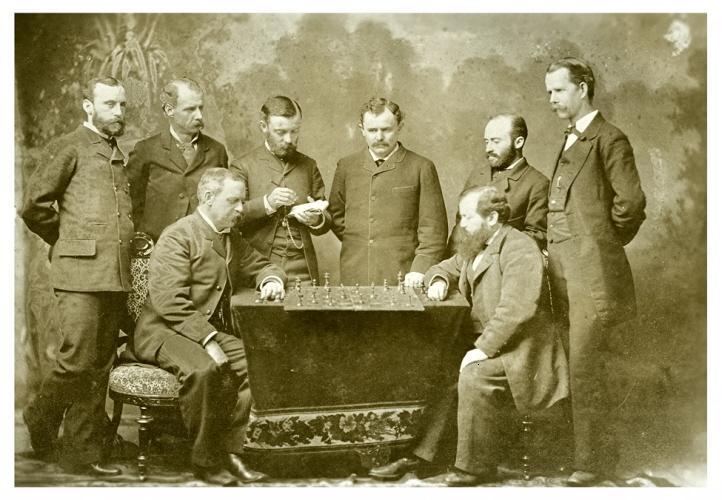
In C.N. 3463 Michael Negele (Wuppertal, Germany) raised the subject of the above photograph. Apart from Steinitz, none of the persons could be identified with certainty, but now our correspondent has found an almost complete key in the Cleveland Public Library:
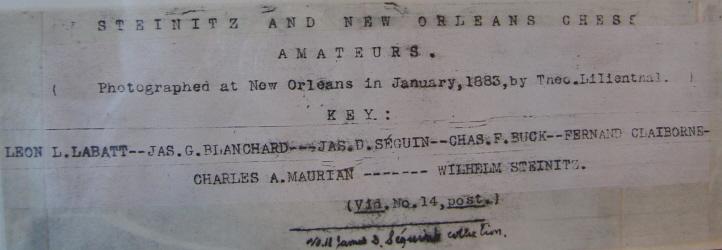

We saw the above position on page 120 of Winning Chess Tournaments by Robert M. Snyder (Lincoln, 2007), with the caption ‘Fleischer versus Amateur, Switzerland, 1938’. Preventing ...Qa1 mate, White played 1 Nf3 Qxh1 2 Ne5, attacking the queen and threatening mate on d7.
Richard Forster (Zurich) informs us that the combination was
published by Henry Grob in his weekly column in the Zürcher
Illustrierte Zeitung (24/1940, page 645). White was named
as Bernhard Fleischer, but no date or place for the game was
given. Nor do we have the complete score.
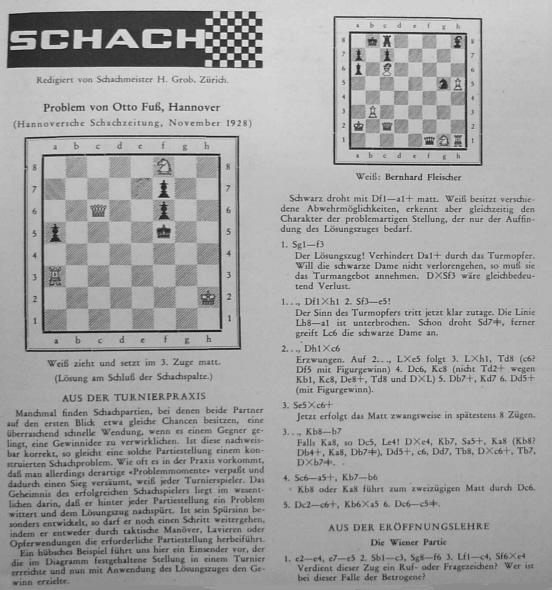
Information is still required on when FIDE adopted the Latin motto Gens una sumus. As mentioned in C.N. 4364, the earliest occurrence in print known to us is surprisingly late: FIDE Revue, 1952.
Stephen Wright (Vancouver, Canada) now quotes a passage from page 184 of Russian Silhouettes by Genna Sosonko (Alkmaar, 2001):
‘The friends and chess colleagues of his [Levenfish’s] youth had been ... Pyotr Potyomkin, poet and chessplayer, who emigrated after the Revolution – a club named after him still exists in Paris, and it was to Potyomkin that the International Chess Federation was indebted for its slogan “Gens Una Sumus” ...’
Mr Wright notes that Potyomkin (or Potemkin) participated in the unofficial FIDE Olympiad in Paris in 1924 and that he died in 1926. What more is known about his claimed connection with Gens una sumus?
Further to the comments by Staunton quoted in C.N. 5128, it may be added that at the start of its 1842 run, in a note entitled ‘Portrait’, Le Palamède stated that no picture of Labourdonnais had existed and that when the master died Deville took a plaster cast of his head. Marlet then undertook a portrait of Labourdonnais:
‘Il n’existe aucun portrait de Labourdonnais. A sa mort, M. Deville moula sa tête. C’est sur ce plâtre et les souvenirs qu’il en conservait que M. Marlet a osé entreprendre de remplir cette lacune. Nos lecteurs jugeront la ressemblance et sauront apprécier toutes les difficultés qu’un artiste de mérite a eu à surmonter pour faire revivre les traits de Labourdonnais.’
Pages 145-147 of the 15 March 1842 issue of Le Palamède carried an article ‘Phrénologie’ which discussed the characteristics of Labourdonnais’ brain. The opening paragraph reported that copies of the bust were to be found in London chess clubs and other haunts and that the master had been subjected to phrenological scrutiny:
‘Le buste de Labourdonnais que nous possédons dans notre Cercle des Echecs et qui se trouve à Londres dans la plupart des clubs et divans où se jouent les échecs, a été moulé sur lui après sa mort, par M. Deville. La tête, dont le travail est des plus soignés, fut soumise à l’examen de la société phrénologique de Londres. Le docteur Elliotson se chargea de présenter son rapport sur cette intéressante communication ...’
A chronology by Dr John van Wyhe of Cambridge University records that John Elliotson and J. DeVille were founding members of the London Phrenological Society in 1823.
A very early appearance of the name ‘Morphy’ in a chess magazine came on page 248 of Le Palamède, 15 May 1842. It was, however, a reference to Ernest Morphy (Paul’s uncle). A feature on chess in the United States mentioned the devastation caused by yellow fever in New Orleans, and stated that Ernest Morphy (‘notre correspondant’) was active in chess there and had sent highly interesting material to Labourdonnais.

Christian Sánchez (Rosario, Argentina) notes that the position was ascribed to Kling and Horwitz in Carlo Salvioli’s book Il giuoco degli scacchi. Our correspondent refers to page 546 of the third (1921) edition, and we can add that as late as 1961, in the eighth edition (page 742), the same text stood. Mr Sánchez points out, though, that on page 6 of Chess Studies and End-Games by B. Horwitz and J. Kling (London, 1889) the units were placed one file to the right:
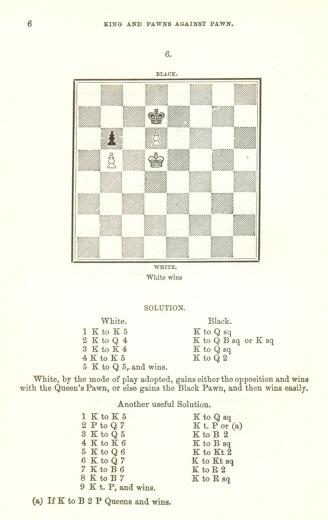
A group photograph from page 127 of the September-October 1928 American Chess Bulletin:
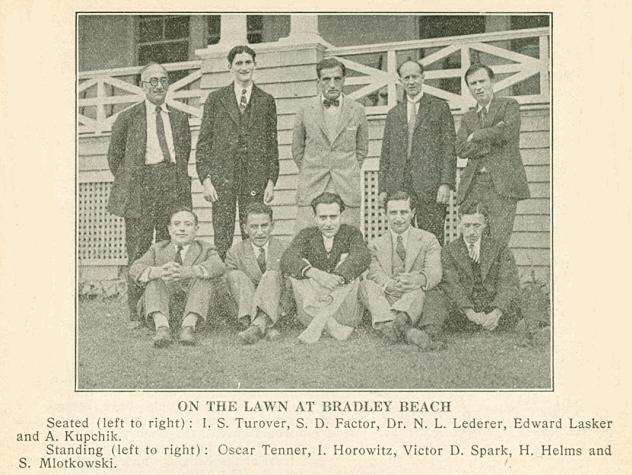
Peter de Jong (De Meern, the Netherlands) reports that there are several references to H.W.B. Gifford in 150 jaar DD (The Hague, 2005), and particularly on pages 29-31, in an article by S.Th. Hogers and W.J.P. Vink. Gifford, an Englishman, was a member of the DD (Discendo Discimus). He won the first unofficial Dutch championship, in the Hague in 1873, moved to Paris in 1877 and, as mentioned in C.N. 5156, participated in the following year’s tournament there (defeating Anderssen). The book also notes that Gifford was a composer. His birth and death details have yet to be established.
C.N. 3202 (see page 281 of Chess Facts and Fables) discussed the claim that in a game at Kemeri, 1937 Alekhine played two moves in succession. His encounter with Vladas Mikėnas has been mentioned in that context, but Sandro Litigio (Como, Italy) writes:
‘An article “How I outplayed Alekhine!” by Mikėnas on pages 52-54 of the January 2006 CHESS has his detailed comments on the game against Alekhine at Kemeri, 1937. As Mikėnas mentions no double move, it would seem that any such incident must have occurred in a different game.’
Olimpiu G. Urcan (Singapore) sends a copy of the front page of Frank Leslie’s Illustrated Newspaper, 3 May 1879:
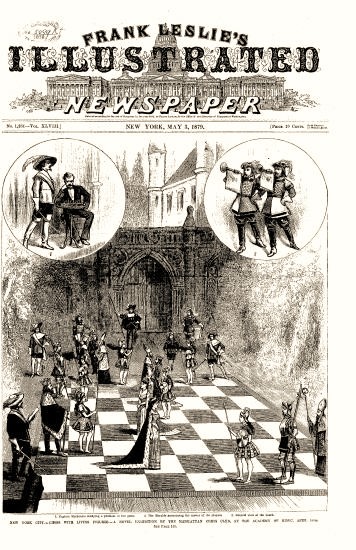
Mr Urcan mentions that the display was discussed, although without the above illustration, on pages 125-141 of Thomas Frère and the Brotherhood of Chess by Martin Frère Hillyer (Jefferson, 2007). We recall that the picture was given on page 24 of the February 1931 American Chess Bulletin and that page 25 quoted the newspaper’s report on the game, which was played in New York on 16 April 1879.
In response to C.N. 4961, which invited examples of the worst chess poems, Avital Pilpel (Haifa, Israel) mentions The Great Pawn Hunter Chess Tutorial (subtitle: Stories, Poetry and Games) by Manus Patrick Fealy (Bloomington and Milton Keynes, 2006). There are indeed many spectacularly unprintworthy specimens in what is, of course, yet another ‘vanity press’ production. In earlier, happier, days, such material might merely have been chalked on the pavement.
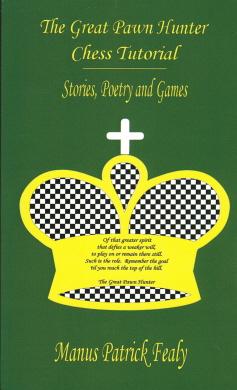
Harrie Grondijs (Rijswijk, the Netherlands) reports that Gens una sumus was on the front cover of Alexander Rueb’s book De Schaakstudie, which appeared in ten parts as from 1949:
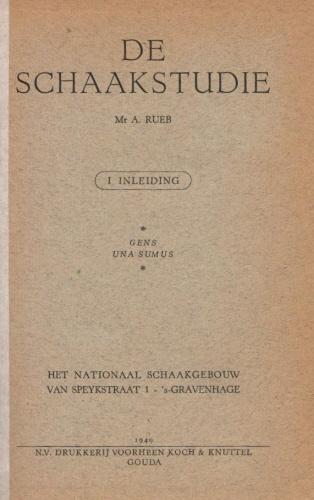
Our correspondent also informs us that he possesses a printed invitation from Rueb, dated Christmas 1945, to the first FIDE Congress of the post-War period. It states:
‘... no Chessfriend should forget, that we are One Nation ...’
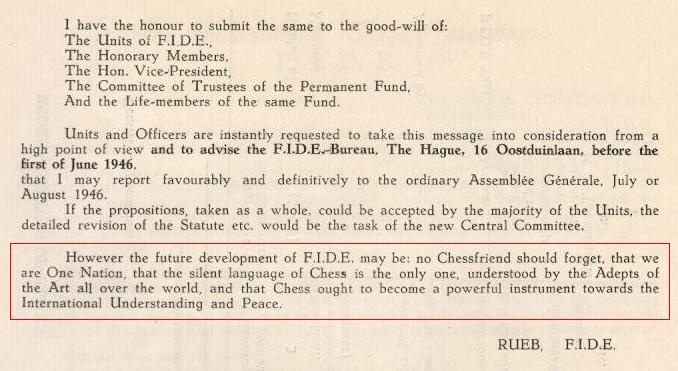
From the obituary of Arnous de Rivière in The Field, 16 September 1905:
‘Latterly his name came into prominence as the organizer of the Monte Carlo tournaments, and he was occupied with the drafting of a constitution for the establishment of an International Chess Association when death overtook him.’
What more is known about that initiative?
Below is a photograph taken during the Czech championship in Mladá Boleslav, 1913:
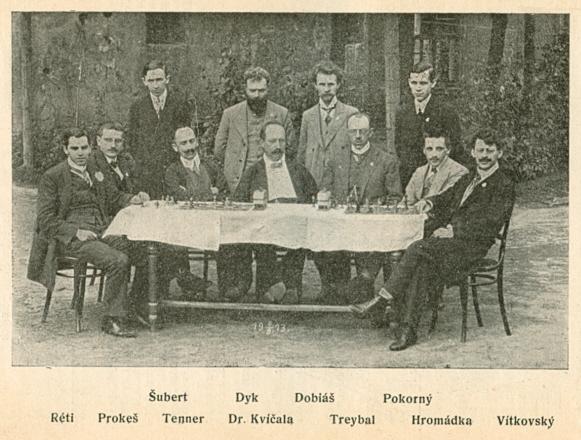
Source: Časopis Českých Šachistů, 9/1913, page 140.
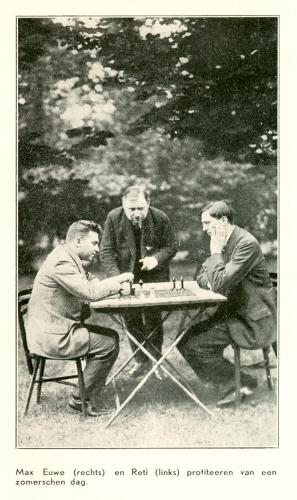
Can any reader identify the third man in this photograph, which comes from Aljechin-Euwe by Guus Betlem Jr (Helmond, 1936)?
Page 20 of Les échecs par la joie by Aristide Gromer (Brussels, 1939) asserted that Ruy López was Montaigne’s cousin. On what grounds?

From page 190 of Modern Chess Strategy by Edward Lasker (London, 1951):
‘I recall a remark which Emanuel Lasker made one day as we were discussing the characteristic differences between the older and the younger generation of chess masters. He said modern tournaments were much harder because the young masters played much more exact chess than was encountered in tournaments up to the great meeting in New York in 1924. He felt that the old masters – Steinitz, Schlechter, Tarrasch, Teichmann, Bernstein, etc. – had played just as deep chess as can be found in any modern game, perhaps even deeper because they played more slowly, but that they lacked the accuracy with which present-day masters took advantage of the slightest positional superiority.’
Further to the reference in C.N. 3156 to a twentieth-century W. Steinitz (see page 277 of Chess Facts and Fables) Michael McDowell (Westcliff-on-sea, England) sends the following, from page 577 of The Problemist, May 1953:
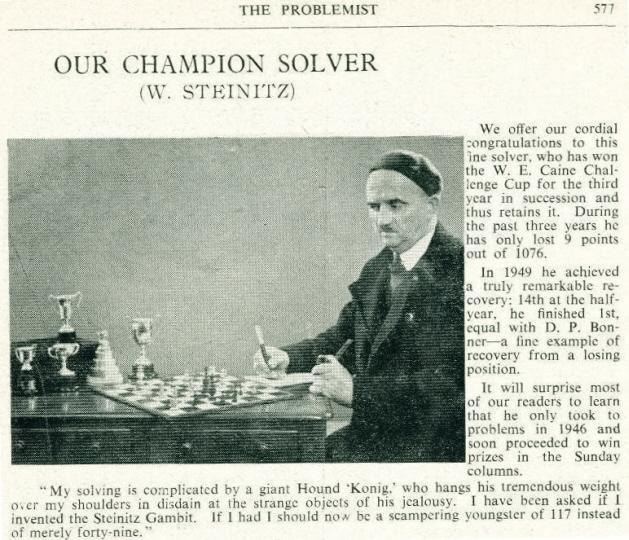
Mr McDowell comments:
‘He was one of the strongest solvers in The Problemist in the late 1940s and the 1950s. His last entry in the solving ladder dates from September 1973. No obituary ever appeared in The Problemist. In 1954 he presented a silver cup to the British Chess Problem Society known as the “Intermediate Cup”; it was to be awarded to the solver who gained the highest points in a section entitled “Our Own Composers”, which was aimed at those with little experience of composition or solving. These days the trophy fulfils a similar function, being awarded to the winner of the solving ladder in The Problemist Supplement.’

We are grateful to Lord Morgan (Oxford, England) for permission to quote a passage from page 130 of his biography of the former British Prime Minister, Callaghan A Life (Oxford, 1997):
‘... Callaghan’s only hobby in the House, useful for filling in time before trooping through the division lobby, was chess, which he played with colleagues such as Douglas Jay, Reginald Paget and Maurice Edelman. Michael Foot was a more dashing performer, and the backbencher Julius Silverman perhaps the strongest Commons player of all. Callaghan’s chess style was unremarkable: he favoured classic openings ... such as the Ruy López and the Sicilian Defence (though, as for many others, the full subtleties of the latter often eluded him). He admired the proficiency of the leading Russians, the current world champion Mikhail Botvinnik and his successors Smyslov and Tal. It marginally underlined his early enthusiasm for the Soviet Union. He kept up his interest in chess throughout his life, being a regular attender at the Hastings chess congress. He even took part in a simultaneous contest with the then Russian world champion Gary Kasparov in 1993, with inevitably very brief results. A good-humoured loser, Callaghan concluded that more intelligence was required for chess than for politics.’
A note on page 134 refers readers to pages 26-27 of the June 1990
CHESS for Lord Callaghan’s interview with Cathy Forbes.
She reproduced it on pages 141-147 of her book Meet the
Masters (Brighton, 1994). See also CHESS, April
1993, pages 4-9.
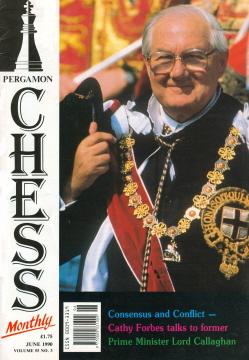
John Hilbert (Amherst, NY, USA) submits an ending from Max Judd’s chess column in the St Louis Globe-Democrat of 31 October 1875, page 3. Theodore Morris Brown was White against an anonymous St Louis amateur:
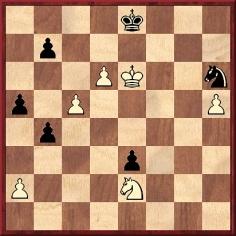
1 c6 bxc6 2 Nd4 Nf7 3 h6 c5 4 d7+ Kf8
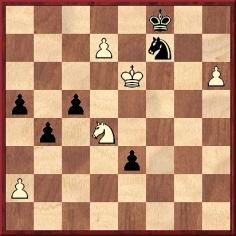
5 Kf6 e2 6 h7 e1(Q) 7 d8(Q)+ Qe8 8.Ne6 mate.
Christian Sánchez (Rosario, Argentina) notes that the Kasparyan position was published as ‘Kasparyan-Manvelyan’ on page 231 of Chess Review, November 1939. Can earlier appearances be found?
From Olimpiu G. Urcan (Singapore) comes this sketch from the Sunday Inter Ocean (Chicago) of 27 December 1896, page 20:
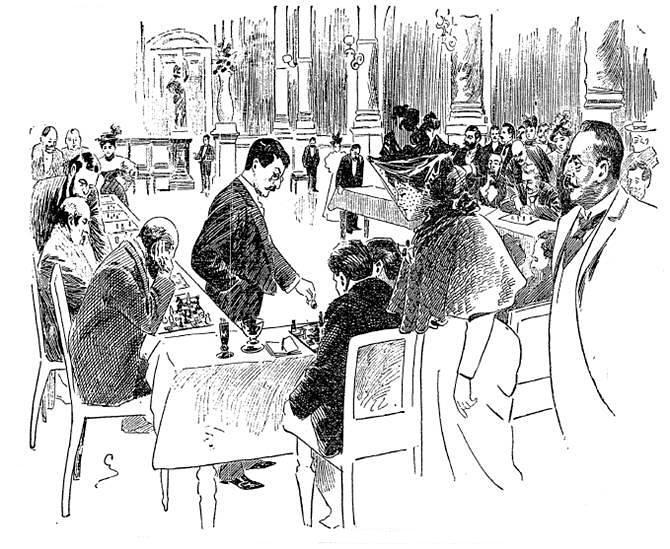
Our correspondent adds that the caption was ‘Lasker, the chess expert, playing several games at the same time at the Kaiserhof, Berlin’, it being specified that the drawing was taken from Zur Guten Stunden.
Published in 1988 by colección Ricardo Aguilera (Madrid), Morphy su vida y 353 partidas by Benito López Esnaola claimed to be an important work of scholarship. As noted in C.N. 1821, the author commented in his introduction: ‘Morphy’s games have been compiled before, but I believe that the present book breaks the record with 353. The previous total was 300.’ The back-cover blurb remarked that 353 was a ‘record figure’ and trumpeted López Esnaola as ‘an excellent investigator of chess history’.
Our earlier item mentioned that such words were considerable exaggerations. Maróczy’s book on Morphy (first published in 1909) contained over 400 games, even though López Esnaola mentioned this predecessor on page 26. On the other hand, he overlooked the second series of unknown Morphy games published by David Lawson in the BCM (September 1979), and showed no evidence of acquaintance with Paul Morphy The Pride and Sorrow of Chess. There were so many misspellings they could hardly be printers’ errors. Pages 18, 26 and 35 referred to the ‘Britisch Chess Magazine’, no doubt by analogy with the ‘Britisch Chess Review’ (page 172). Staunton’ column was in the ‘Ilustration London’ (page 14), the ‘Ilustrated London News’ (pages 15, 16 and 172) and the ‘Ilustrated London’ (pages 17 and 18). Other nineteenth-century revelations were ‘McConnel’, ‘Rouseau’, ‘La Bourdonais’, ‘Lichtenthein’, ‘Lichtentheim’, ‘Lichtenheim’, ‘Lyttleton’, ‘Lytleton’, ‘Harwitz’, ‘St Jame’s Chess Club’, ‘Ilustrated Sportin and Dramatic News’, ‘MacDonnel’ , ‘Zukertot’ , ‘Andersen’, ‘Cuningham’, ‘Sucre’, ‘La Palamede’ and ‘Delandy’.
In addition, López Esnaola’s book concluded with six pages of biographical notes on Morphy’s opponents. They were simply purloined from the footnotes in Morphy’s Games of Chess by P.W. Sergeant.
Our feature article The Capablanca-Pokorny Fiasco quoted a remark about Rudolph Pokorny from page 246 of the November 1909 American Chess Bulletin:
‘Through Mr Louis Uedemann of Chicago we learn that the Austro-Mexican had been a resident of that city some years ago and was well known to chessplayers there.’

Now Jerry Spinrad (Nashville, TN, USA) quotes the following from page 8 of the Chicago Daily Tribune, 22 November 1907:
‘Return to Find Partner Gone. Business Associates Accuse Rudolph Pokorny of Appropriating Funds While They Are on Vacation.
Rudolph Pokorny, former manager of the hair-dressing parlors of Rudolph Pokorny & Co., 165 Wabash Avenue, is being sought by his late partners, who accuse him of having absconded with some $400. According to V. Henry, one of the partners, Pokorny, who is a well-known chessplayer, two months ago formed the partnership with Henry E. Rhode and T. Alfred. Henry stated that Pokorny disappeared while the other partners were absent on a trip.’
Our correspondent comments:
‘Thus he is the same Rudolph Pokorny who was given to ridiculous puffery for his hair-styling in a Tribune article of 17 June 1906. Any doubt that the Chicago Pokorny and the Mexican Pokorny are the same is dispelled by Uedemann’s column of 1 August 1909; along with his challenge to Capablanca, Pokorny challenged his old Chicago club to a correspondence match.
Both “Rudolf” and “Rudolph” were used in advertisements for Pokorny’s hair salon. Strangely, the only mention I have of a Pokorny in Chicago chess (no first name is given) is in Uedemann’s column of 8 December 1907, which said that he had played in a consultation match the previous Monday. This would seem odd, since it would put him in public in Chicago after he absconded with the money.
The New York Sun of 24 October 1909, third section, page 8, gave Pokorny’s occupation as an importer of French tonics in its discussion of the Capablanca challenge.’

Peter de Jong (De Meern, the Netherlands) suggests – and we believe him to be correct – that the person standing is Willem Schelfhout (1874-1951). Below is a photograph published on page 136 of the February 1951 Tijdschrift van de Koninklijke Nederlandse Schaakbond:
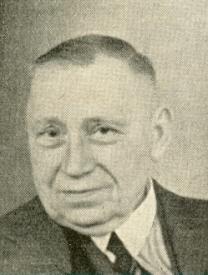
Willem Andreas Theodorus Schelfhout
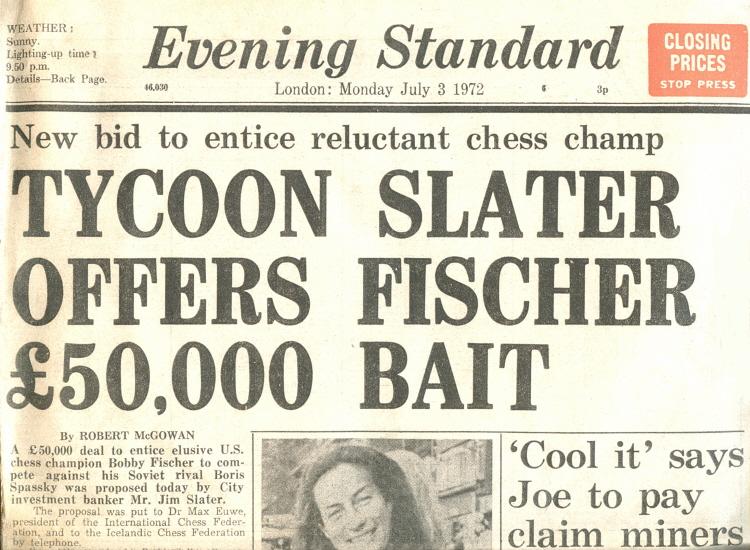
For Leonard Barden’s account of the episode, see pages 26-27 of CHESS, November 1997.
We summarize the proof that the match in Paris between Lasker and Janowsky in autumn 1909 (won by Lasker +7 –1 =2) was not for the world championship. First, an extract from a letter that we contributed on pages 305-306 of the July 1985 BCM:
‘A check of all major chess periodicals for 1909 at the Royal Library at the Hague reveals that:
a) In many magazines the idea of the match being for the world championship is simply not mentioned (e.g. BCM pages 483 and 543).
b) Others are specific that the title was not at stake (e.g. Deutsches Wochenschach und Berliner Schachzeitung page 382, Tijdschrift van den Nederlandschen Schaakbond page 253). The match was played in Paris, so it is no surprise that French-language magazines are especially precise in refuting any world championship connection (e.g. La Stratégie pages 352 and 407, and Revue d’échecs page 214).
c) Not a single contemporary magazine has been found that suggests the match was for the world crown.’
Further details were given in C.N. 2471 (see page 174 of A
Chess Omnibus), as reproduced below.
On 15 September 1909 Lasker and Schlechter issued a joint announcement (from Berlin and Vienna) of their intention to play a world championship match during the coming winter. The text was published in the Wiener Schachzeitung, September 1909 (page 315) and the Deutsche Schachblätter, 3 October 1909 (page 85). Not surprisingly, therefore, contemporary magazines did not suggest that the ten-game Lasker-Janowsky encounter played from 19 October to 9 November 1909 was for the world title, and some (especially the French ones) specifically stipulated that it was not. Page 214 of the 1909 Revue d’échecs said that it was merely ‘un second duel courtois’. Page 352 of the October 1909 La Stratégie observed that because of the Lasker-Schlechter agreement Janowsky would have to wait for a title match until afterwards. In its November 1909 issue (page 407) La Stratégie reported that Janowsky was not discouraged by his heavy loss to Lasker in Paris and added: ‘we understand that fresh discussions are already under way between the same players for another, more important, match, one which will count for the world championship, subject, naturally, to the Champion’s victory in his forthcoming match against Schlechter.’
On pages 60-61 of the February 1910 La Stratégie [reproduced below] it was reiterated that Lasker and Janowsky had not played for the title in Paris, and the magazine published the full text of an agreement signed by the two masters in the French capital on 12 November 1909. This was for a match that would begin in October or November 1910, and clause 15 stated: ‘The match shall be for the championship of the world. If Dr E. Lasker loses his title in his forthcoming match with Schlechter, the entire present arrangement shall, naturally, be void.’
Lasker survived against Schlechter, and in Berlin on 8 November 1910 there duly began the one and only world championship match between Lasker and Janowsky.
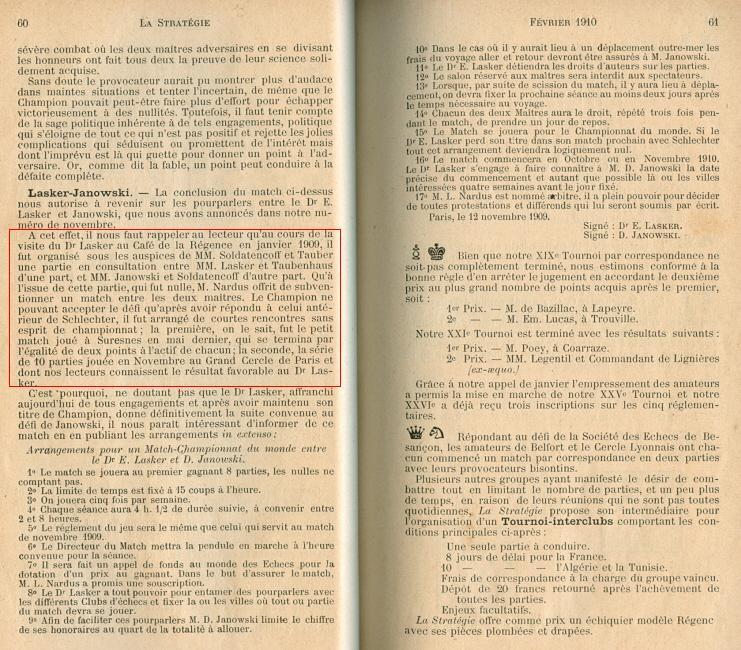
| First column | << previous | Archives [38] | next >> | Current column |
Copyright 2007 Edward Winter. All rights reserved.